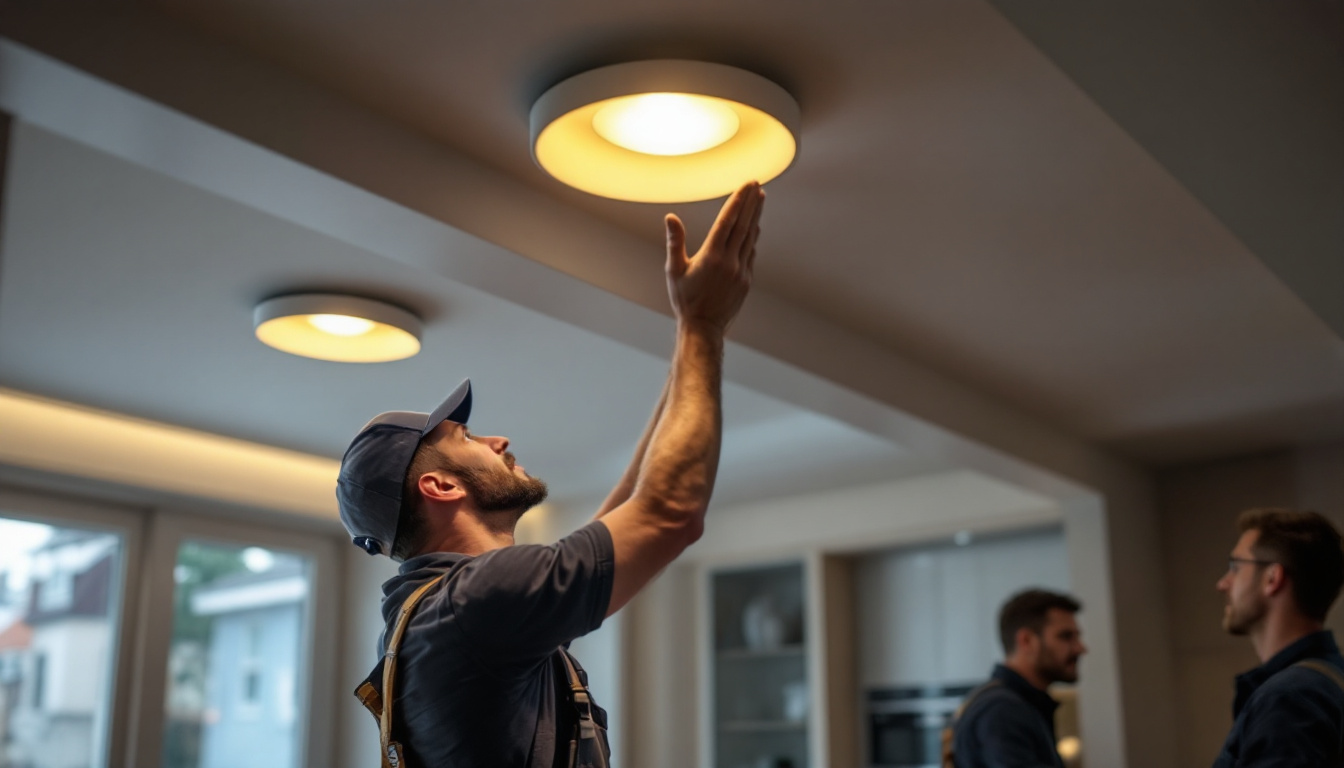
In the world of industrial lighting, shop floor lights play a crucial role in ensuring safety, productivity, and efficiency. For lighting contractors, understanding the nuances of these fixtures is essential for delivering optimal solutions to clients. This guide will delve into the various aspects of shop floor lighting, from types and technologies to installation considerations and maintenance practices.
Shop floor lighting is not just about illuminating a space; it’s about creating an environment that fosters productivity and safety. The right lighting can significantly enhance visibility, reduce accidents, and improve the overall working atmosphere. Different types of shop floors, such as manufacturing plants, warehouses, and assembly lines, have unique lighting needs that must be addressed.
Proper lighting is vital for several reasons. First and foremost, it affects worker safety. Poorly lit areas can lead to accidents and injuries, making it essential to ensure that all areas are adequately illuminated. Additionally, proper lighting enhances visibility, which is crucial for tasks that require precision and attention to detail.
Moreover, the right lighting can influence employee morale and productivity. A well-lit environment can reduce fatigue and eye strain, leading to a more efficient workforce. Consequently, investing in quality shop floor lighting is not just a regulatory requirement; it’s also a strategic business decision. Studies have shown that employees working in well-lit environments tend to be happier and more engaged, which can lead to lower turnover rates and a more cohesive team dynamic.
There are several types of lighting options available for shop floors, each with its own set of advantages and applications. Understanding these options allows contractors to recommend the best solutions for their clients’ specific needs.
LED lights have gained immense popularity in industrial settings due to their energy efficiency and longevity. They consume significantly less power compared to traditional incandescent or fluorescent lights, leading to reduced energy costs. Additionally, LEDs have a lifespan that can exceed 50,000 hours, minimizing the need for frequent replacements.
Furthermore, LED technology offers versatility in design and functionality, allowing for various configurations such as high-bay, low-bay, and task lighting. This adaptability makes them suitable for different shop floor layouts and activities. Beyond their practical benefits, LEDs also come in a range of color temperatures, enabling businesses to create specific atmospheres that can enhance focus or stimulate creativity, depending on the nature of the work being performed.
Fluorescent lights have been a staple in industrial lighting for decades. They provide a bright, even light that is effective for large areas. While they are less energy-efficient than LEDs, they still offer a good balance between cost and performance.
Fluorescent fixtures are often used in conjunction with reflectors to enhance light distribution, making them suitable for spaces with high ceilings. However, it’s important to note that fluorescent lights contain mercury, which requires careful disposal and handling. Additionally, advancements in technology have led to the development of energy-efficient fluorescent options that can help mitigate some of the environmental concerns associated with traditional fluorescent lighting, making them a more sustainable choice for businesses looking to reduce their carbon footprint.
HID lights, including metal halide and high-pressure sodium lamps, are known for their powerful illumination. They are particularly effective in large industrial spaces where high ceilings are common. HID lights provide excellent color rendering, making them ideal for tasks that require accurate color perception.
However, HID fixtures typically have longer warm-up times and shorter lifespans compared to LEDs. As such, they may not be the best choice for environments that require instant-on lighting or frequent cycling. Despite these drawbacks, many industries still rely on HID lighting for its ability to cover vast areas with minimal fixtures, thus reducing initial installation costs. Furthermore, with the advent of smart lighting controls, HID systems can now be integrated into automated lighting solutions, allowing for enhanced energy savings and operational efficiency in large-scale operations.
When selecting and installing shop floor lights, several factors must be taken into account to ensure optimal performance and compliance with safety regulations. Lighting contractors should be well-versed in these considerations to provide the best solutions for their clients.
Illuminance, measured in lux or foot-candles, refers to the amount of light that reaches a surface. Different tasks require varying levels of illuminance. For instance, general warehouse areas may require around 100-300 lux, while assembly lines or inspection areas may need 500-1000 lux or more.
Contractors should assess the specific activities taking place in the shop floor to determine the appropriate illuminance levels. This assessment will help in selecting the right fixtures and placements to achieve the desired lighting conditions. Moreover, it is essential to consider how these levels may change throughout the day or with different operational shifts, as fluctuating natural light can impact overall visibility. Implementing a lighting control system that adjusts based on the time of day or occupancy can further enhance efficiency and reduce energy costs.
Color temperature, measured in Kelvin (K), affects the mood and functionality of a workspace. Warmer color temperatures (around 2700K-3000K) create a cozy atmosphere, while cooler temperatures (5000K and above) promote alertness and concentration.
For shop floors, a color temperature of around 4000K-5000K is often recommended, as it provides a balance between visibility and comfort. Understanding the psychological effects of color temperature can help contractors make informed decisions that enhance the working environment. Additionally, the choice of color temperature can influence employee productivity; cooler lights can help maintain focus during repetitive tasks, while warmer lights may be better suited for areas where workers take breaks or engage in collaborative discussions. Balancing these elements can lead to a more harmonious and efficient workplace.
The layout of fixtures is crucial for achieving uniform lighting across the shop floor. Contractors should consider factors such as ceiling height, the layout of equipment, and the tasks being performed when determining fixture placement.
Using lighting design software can aid in visualizing the layout and ensuring optimal light distribution. Additionally, contractors should take into account potential obstructions that could cast shadows or create dark spots, which could hinder visibility and safety. It’s also important to consider the maintenance of the fixtures; placing lights in accessible locations can simplify bulb replacement and cleaning, ensuring that the lighting remains effective over time. Furthermore, incorporating a mix of ambient, task, and accent lighting can create a layered lighting approach, enhancing both functionality and aesthetic appeal in the workspace.
Proper installation of shop floor lights is essential for maximizing their effectiveness and longevity. Lighting contractors must adhere to best practices to ensure that fixtures are installed safely and efficiently.
Lighting contractors must be familiar with local and national regulations regarding workplace lighting. Compliance with standards such as the Occupational Safety and Health Administration (OSHA) guidelines is crucial for ensuring safety and avoiding potential liabilities.
Understanding these regulations not only helps in creating a safe working environment but also enhances the contractor’s credibility and reputation in the industry.
Electrical considerations are paramount during installation. Contractors should ensure that the electrical systems can handle the load of the new lighting fixtures. This may involve upgrading circuits, ensuring proper grounding, and adhering to electrical codes.
Additionally, incorporating energy-efficient technologies, such as motion sensors and dimmers, can further enhance energy savings and improve the overall lighting experience.
After installation, thorough testing and commissioning of the lighting system are essential. This process involves verifying that all fixtures are functioning correctly and that the desired illuminance levels are achieved throughout the space.
Contractors should conduct light level measurements using a light meter and make any necessary adjustments to fixture placement or settings. Documenting these results can provide valuable information for future maintenance and upgrades.
Regular maintenance of shop floor lighting is crucial for ensuring long-term performance and safety. Lighting contractors should educate their clients on the importance of ongoing maintenance practices.
Routine inspections should be conducted to check for any signs of wear or damage to the fixtures. This includes looking for burnt-out bulbs, flickering lights, or any physical damage to the fixtures themselves. Early detection of issues can prevent larger problems down the line.
In addition to visual inspections, contractors should also assess the cleanliness of fixtures. Dust and grime can accumulate over time, reducing the effectiveness of the lighting. Regular cleaning schedules can help maintain optimal performance.
As technology advances, lighting options continue to evolve. Contractors should stay informed about new products and advancements in lighting technology. Recommending upgrades to more efficient fixtures can lead to significant energy savings and improved lighting quality for clients.
Additionally, when replacing fixtures, contractors should consider the overall lighting design and whether adjustments are needed to accommodate new technologies or changes in the shop floor layout.
Shop floor lighting is a critical aspect of industrial environments, influencing safety, productivity, and overall worker satisfaction. For lighting contractors, understanding the various types of fixtures, installation best practices, and maintenance requirements is essential for delivering effective solutions to clients.
By considering factors such as illuminance levels, color temperature, and compliance with regulations, contractors can create well-lit environments that enhance operational efficiency. With ongoing maintenance and a commitment to staying informed about industry advancements, lighting contractors can ensure that their clients benefit from optimal lighting solutions for years to come.
Ready to elevate your lighting projects with the highest quality solutions? Look no further than LumenWholesale, where we specialize in providing lighting contractors with spec-grade lighting products at unbeatable wholesale prices. Say goodbye to inflated markups and hello to a vast selection of reliable, high-performance lighting that meets the most rigorous industry standards. Plus, with free shipping on bulk orders, you can secure premium lighting at the best value without any hidden fees. Don’t compromise on quality or cost. Make the smart choice and experience the best in wholesale lighting with LumenWholesale today.

Discover the advantages of recessed downlights for lighting contractors, from enhanced aesthetics to energy efficiency.

Discover how landscaping lights can enhance efficiency for lighting contractors.

Discover the transformative impact of huge solar lights on modern lighting projects.

Discover expert strategies and proven techniques for lighting contractors to select and install commercial light fixtures.